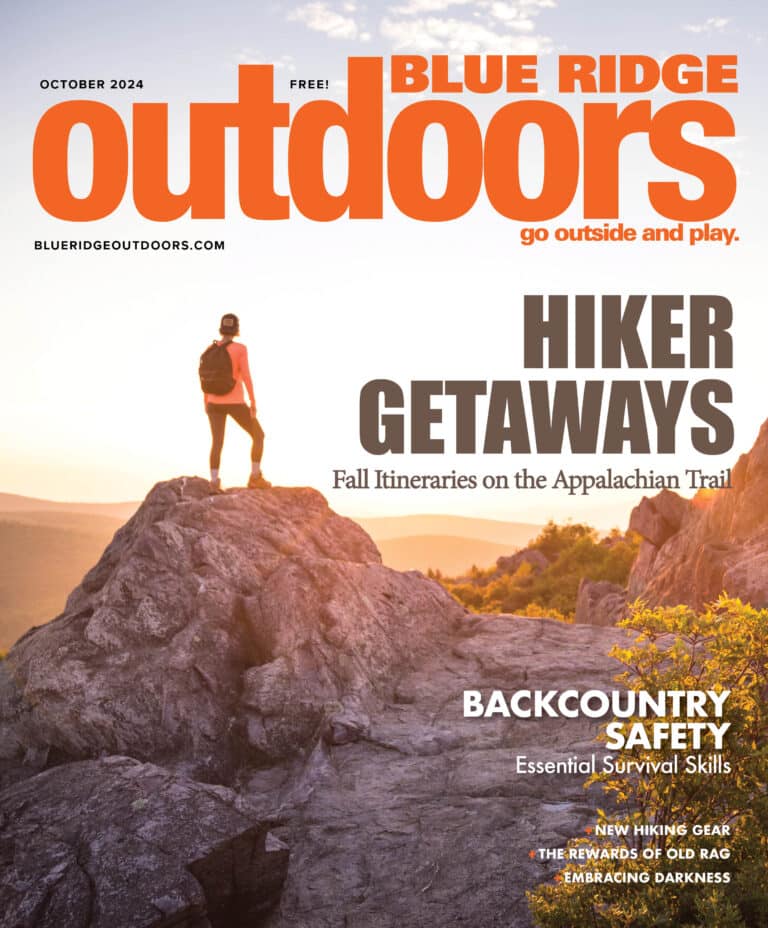photo by Steven McBride
Rural neighbors build a national coalition to protect a wild, ancient forest as the Craggy National Scenic Area
Four years ago, a small group of Appalachian farmers, teachers, and carpenters sat around a wobbly table in their community center. They were worried: logging threatened the old-growth forest that surrounded their valley. So they began spitballing ideas about how to save it. They sketched out a plan that included door-to-door conversations, flyers at the local gas station, and a community meeting later that month. “We didn’t know what we were doing,” admitted Steven McBride, one of the neighbors around the table. “But we had to try. We just decided to go for it and got to work.”
They were hoping to protect the 16,000-acre Craggy section of Pisgah National Forest in western North Carolina. It includes ancient forests, waterfalls, pristine streams, 6,000-foot summits, world-class trails like the Mountains to Sea Trail, and panoramic vistas from Craggy Gardens, the most popular and photographed spot along the Blue Ridge Parkway.
The neighbors invited the Forest Service to attend the community meeting. The Forest Service managed the Craggy forest, and on the evening of the meeting, they showed up first. The community center was empty, except for a few volunteers offering apple cider and cookies to anyone who showed up.
Then the first few attendees wandered in—mountain families wearing hand-made t-shirts that said, “Don’t Cut Our Forest.” Scientists from three area universities arrived next. More vehicles pulled into the gravel parking lot—including dirt-splattered pickups and bumper-stickered Priuses. The organizers quickly ran out of cider and cookies. The community center filled to capacity with over 300 people, and more folks continued to arrive. On a cold, dark February night, they stood at the windows of the community center and waited out in the parking lot. Nearly everyone in attendance asked the Forest Service to permanently protect the Craggy forest. Fifth-generation farmers and hunters voiced support for keeping Craggy as it is. Seven-year-olds spoke with quivering voices to the Forest Service: “Don’t cut Craggy. Keep it wild.”
The Forest Service listened, and last month, they responded. In their 30-year draft forest plan, they acknowledged the rare and special qualities of the Craggy forest, and they recommended stronger protections for Craggy across all of its plan alternatives.
The momentum has ignited a national movement to create the Craggy Wilderness and National Scenic Area, which would permanently safeguard all 16,000 acres of Craggy. Craggy is one of the oldest and most biologically diverse forests in the country. It shelters dozens of rare and endangered species. Hollywood blockbusters have been filmed in Craggy’s enchanted forests, including The Hunger Games and The Last of the Mohicans. Waterfalls thunder down its rugged slopes.
The grassroots gathering in the community center has quickly grown into a national coalition that includes hundreds of organizations and businesses—and thousands of supporters. The Forest Service has already received thousands of comments endorsing permanent protections for Craggy, and city council and county commissioners have passed unanimous bipartisan resolutions supporting the Craggy Wilderness and expanded protections for all of Craggy.
Now, the coalition is working with Congress to introduce the Craggy Mountain Wilderness and National Scenic Area Act to permanently protect Craggy. Craggy’s rugged, remote slopes would be recommended for wilderness designation, and the rest of Craggy—including its popular trail network—would be designated a national scenic area. “This is Craggy’s big moment,” says Hannah Furgiuele, one of the original Craggy organizers. “This is a rare and unique opportunity to permanently protect one of the wildest and most ancient forests in the East.”
The United States only has 10 national scenic areas. Craggy could become the country’s eleventh.
What exactly are national scenic areas? They are federally designated public lands that have outstanding natural and scenic value. Craggy certainly qualifies as scenic. It includes the sweeping, breathtaking vistas from 6,000-foot Craggy Pinnacle and the Craggy Gardens Visitor Center along the Blue Ridge Parkway. The Mountains-to-Sea Trail—North Carolina’s state trail, stretching almost 1,200 miles from the Smokies to the Outer Banks—rolls through the Craggy’s high-elevation spruce-fir forests. Craggy is also part of a contiguous 100,000-acre block of protected wildlands, including Mount Mitchell, the highest summit in the East. These vast, rugged wildlands were once nominated to be a national park.
A National Scenic Area might be the next best thing. National Scenic Area designations overlay existing public lands, such as national forests. Like wilderness, a national scenic area requires an act of Congress. However, national scenic areas are more flexible and adaptable than wilderness. National Scenic Areas can accommodate a wider variety of uses, including mountain biking. The Forest Service can recommend national scenic area designations in their forest plan, and the Craggy coalition hopes that they will. The Forest Service is currently seeking public comments on their draft forest plan for Craggy and the entire Pisgah National Forest. Already letters and emails supporting a Craggy National Scenic Area have flooded the Forest Service, and a supporting petition has collected over 5,000 signatures in just two weeks.
Virginia boasts three of the country’s 10 national scenic areas, and Georgia is also home to a national scenic area. The designations’ flexibility—and Blue Ridge region’s natural scenic qualities—make the national scenic area designation an ideal fit for many classic Appalachian landscapes like Craggy. Could Craggy become the South’s fifth national scenic area—and North Carolina’s first? “There is nowhere more scenic and more stunningly spectacular than Craggy,” said Rob Lenfestey, neighbor and co-organizer of the I Heart Craggy campaign. “Craggy has all the ingredients to become the country’s next national scenic area: overwhelming public support, unanimous bipartisan support, and some of the most jaw-droppingly beautiful and biologically diverse forests in the country.”
You can also sign a petition and learn more about the Craggy National Scenic Area at iheartcraggy.org.
Southern Pride: The South boasts more national scenic areas than any area of the country, thanks to its stunning vistas and abundant recreational opportunities.
National Scenic Areas in the United States + Year Designated
• Mono Basin, California (1984)
• Columbia River Gorge, Oregon and Washington (1986)
• Indian Nations, Oklahoma (1988)
• Beech Creek, Oklahoma (1988)
• Mount Pleasant, Virginia (1994)
• Coosa Bald, Georgia (1995)
• Saint Helena Island, Michigan (2000)
• Seng Mountain, Virginia (2009)
• Bear Creek, Virginia (2009)
• Alabama Hills, California (2019)







